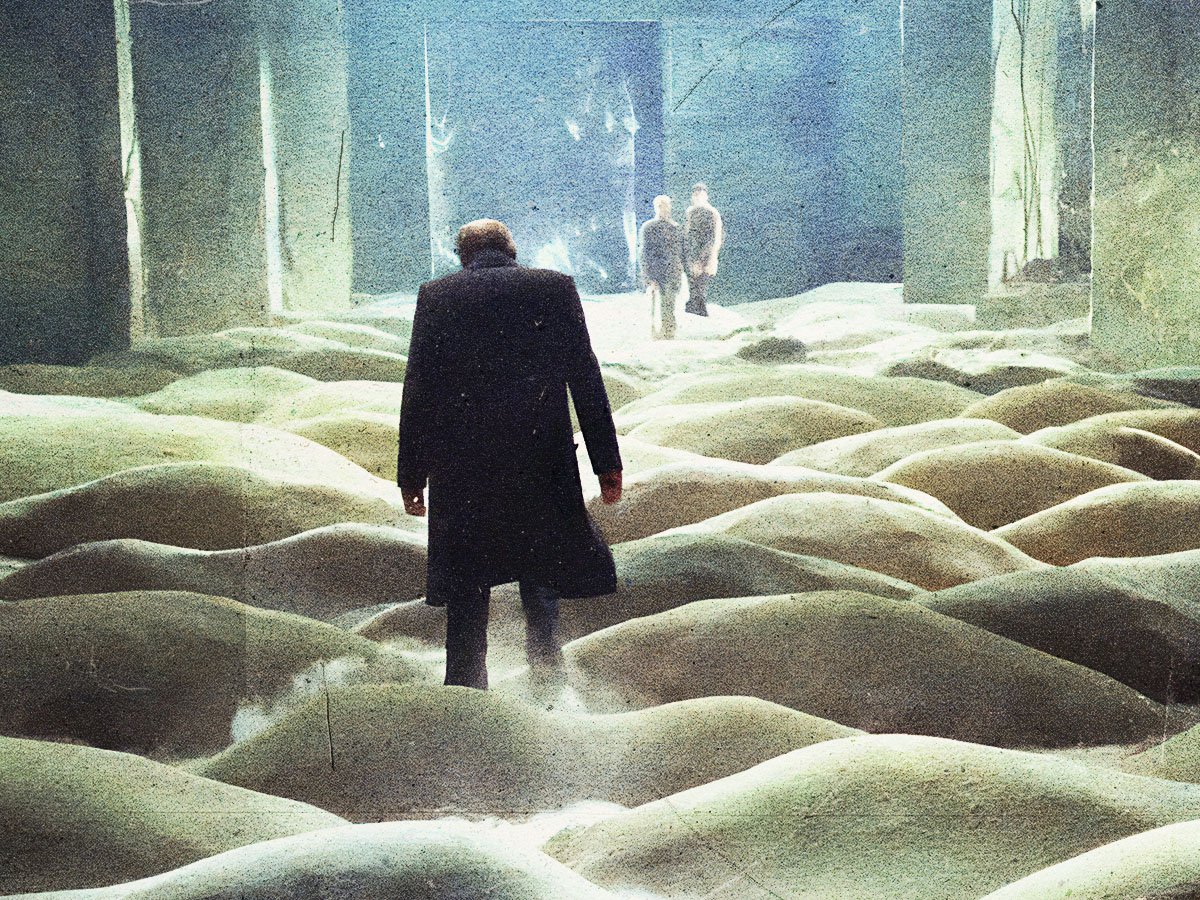
(Credits: Far Out / Mosfilm)
Often, when we think of a Hollywood blockbuster, it’s the sci-fi genre that we most closely associate with such big-budget projects. Whether it be the planet-leaping excess of Christopher Nolan’s Interstellar or the thought-provoking extravaganzas from the modern master Denis Villeneuve, when most movie lovers think of sci-fi, Hollywood is the first celestial land that comes to mind.
Yet, to simply consider American cinema is to disregard some of the best and certainly some of the most influential sci-fi movies of all time. After all, even though the genre is widely associated with Hollywood, the so-called ‘mother and father of science fiction’ pioneered the beloved form of writing outside of America, with French author Jules Verne penning Twenty Thousand Leagues Under the Sea in 1970 and English novelist Mary Shelley writing Frankenstein in 1818.
Ever since, sci-fi has thrived across the world, with some of the greatest sci-fi movies in cinema history having emerged from Europe, Asia and beyond. This list will explore just ten of these iconic foreign science fiction films, uncovering forgotten gems from unknown directors while praising classic works from some of the greatest filmmakers of all time, from Andrei Tarkovsky to Fritz Lang.
Sci-fi lovers, pay attention; these ten movies should be considered as vital to your understanding of the genre as Stanley Kubrick’s 2001: A Space Odyssey, Jonathan Glazer’s Under the Skin and the Wachowskis Matrix.
The 10 greatest foreign sci-fi movies:
10. The City of Lost Children (Marc Caro, Jean-Pierre Jeunet, 1995)
Before Jean-Pierre Jeunet made his most well-known movie, Amélie, he teamed up with his good friend Marc Caro to make two science-fiction movies which revelled in the fantastical. Delicatessen came first before The City of Lost Children, which just slightly takes the upper hand. With a great score by frequent David Lynch collaborator Angelo Badalamenti, the movie has a similar aesthetic to Amélie, although it is considerably more surreal and steampunk-influenced.
The movie follows a group of men who retrieve dreams from children, which leads them to subject a five-year-old to their torturous method of extraction. Thus, the child’s father and friend set out to save him. It’s fun, heartfelt and visually impressive – what’s not to love?
9. Je t’aime, je t’aime (Alain Resnais, 1968)
Alain Resnais wasn’t as closely associated with the French New Wave movement as filmmakers like Jean-Luc Godard and François Truffaut, but he still contributed to this era of French cinema significantly. Using atypical techniques within much of his work, such as nonlinearity, he became highly acclaimed. While he is best known for directing movies like the stylish Last Year At Marienbad, he tried his hand at science fiction with Je t’aime, je t’aime in 1968.
The film sees a man participate in time travel following his discharge from the hospital. Haunted by memories and experiences of the past, the time travel experiment doesn’t exactly go as planned. It’s a great dissection of time, memory and mortality, even inspiring the 2004 film Eternal Sunshine of the Spotless Mind.
8. Solaris (Andrei Tarkovsky, 1972)
Creating his movie partly due to the adulation that Stanley Kubrick received for his epic 1968 film 2001: A Space Odyssey, which Tarkovsky thought was “cold and sterile”, Solaris was one of the Russian filmmaker’s most ambitious projects. A deep and complex tale, Solaris tells the story of a psychologist who is sent to a space station to find out why the crew have gone insane, with the likes of Natalya Bondarchuk and Donatas Banionis taking starring roles.
A baffling piece of cinema from Andrei Tarkovsky, Solaris has long been championed for its density, with every shot being pact with emotional heft way beyond what can be merely seen on the surface. Shot in a striking, unique style, if you don’t find Solaris’ visuals memorable, there’s no doubt that you’ll remember its intricate message, exploring how love influences and alters human endeavour.
7. La Jetée (Chris Marker, 1962)
If you’ve only got half an hour to spare, Chris Marker’s La Jetée is ideal. The movie is a seminal entry to the sci-fi genre, blending experimentalism with themes of time travel and dystopia. The movie largely uses still photographs and voiceover to deliver the narrative, an innovative technique that helped carve Marker out as one of France’s most unique filmmakers.
La Jetée takes place after a nuclear disaster renders the earth uninhabitable, leading humans to live underground. Meanwhile, experiments in time travel are in development, with the film’s protagonist repeatedly going back to previous years, using a specific memory of seeing a man’s death on a jetty to harness him to the past.
6. Fantastic Planet (René Laloux, 1973)
In 1973, René Laloux and Roland Topor joined forces to create a sci-fi tale that used hand-drawn animation to tell the story of an alternative reality where humans are kept as pets – Fantastic Planet. Their owners are blue humanoid aliens with glowing red eyes who see humans as nothing more than animals to keep captive.
It’s a beautifully crafted movie, rich with colour, surrealism and psychedelia. The soundtrack, composed by Alain Goraguer, is similarly psychedelic, evoking an otherworldly atmosphere that is perfectly fitting. The movie is a must-watch for any science-fiction fan and is open to wide interpretation, although many viewers believe that the movie is a metaphor for animal cruelty.
5. Alphaville (Jean-Luc Godard, 1965)
French New Wave master Jean-Luc Godard isn’t the first name that springs to mind when you think of science fiction filmmaking, but the director tipped his toes into the genre for the first time in 1965 with Alphaville. The movie stars American actor Eddie Constantine in the leading role, with French icon Anna Karina in a supporting part. Shot in shadowy black-and-white, Godard proved that he was capable of utilising his style within a different genre than he was used to.
He did this by shooting on location without any fancy sets, in line with the French New Wave’s ethos. In keeping with his typical style, he made the most of his surroundings to create a movie that felt authentically dystopian. By doing so, he actually emphasised how much of the present possessed a dystopian and futuristic sensibility as cultural and technological innovations were rapidly taking place.
4. Akira (Katsuhiro Otomo, 1988)
In modern cinema, animation has become one of the greatest avenues to explore science fiction tales, with the medium offering total creative control to whoever tries to harness its difficulty. The 1988 anime Akira by director Katsuhiro Otomo exemplifies how animation can be used as one of the greatest forms of sci-fi storytelling, following the tale of a biker gang in Neo-Tokyo who become embroiled in a military plot involving a super weapon.
One of the most gorgeous animated movies ever made, Akira changed how anime was consumed across the world, drastically elevating the filmmaking medium. Packed with detail, Otomo is credited with helping to bring to life one of the most fully-realised dystopias ever put to film, with Akira heavily influencing such later movies as Inception and even Netflix’s Stranger Things.
3. Ghost in the Shell (Mamoru Oshii, 1995)
From one essential animation to the next, Mamoru Oshii’s 1995 classic Ghost in the Shell, which itself was inspired by the aforementioned Akira, arrived at the perfect time, being a major voice in the cinematic conversation regarding technology at the turn of the new millennium. In the film, a cyborg policewoman hunts down an insidious hacker while traversing the tribulations of 2029’s fictional New Port City.
Boasting a pioneering visual aesthetic that launched viewers directly into the world of the film, Ghost in the Shell combined a masterful grasp of its technical elements with a story that feels way ahead of its time. Well-predicting the rise of specific technologies, the film questions humanity’s relationship with a life of digital progress, suggesting that a time will soon come when humankind and machines become one.
2. Metropolis (Fritz Lang, 1927)
If there’s one takeaway from this list, it should be that foreign sci-fi movies, not Hollywood fodder, have proved to be the most pioneering releases from the genre. No film proves this clearer than Fritz Lang’s 1927 classic Metropolis, which went on to inspire such movies as Ridley Scott’s Blade Runner and George Lucas’ Star Wars with its take on artistic and political take on the future of humanity.
Set in a towering futuristic city, Metropolis explores a class system that splits a society in two and the emergence of a prophet from the proletariat who predicts imminent change. A visionary piece of science fiction that pulled from the German Expressionism art movement, Lang’s film presented a plethora of new ideas that the genre had never seen before, giving us the basis for many concepts that we take for granted in storytelling today.
1. Stalker (Andrei Tarkovsky, 1979)
Forget foreign cinema, even in lists of the greatest sci-fi movies of all time, Andrei Tarkovsky’s iconic 1979 classic Stalker comes out on top, rubbing shoulders with Stanley Kubrick’s 2001: A Space Odyssey epic. Sealed off by the government, the story concerns an area called ‘The Zone’, which holds the ability to grant whoever visits its heart their deepest desires, with one man leading two desperate souls through the strange wilderness.
A hypnotising movie, the philosophical meaning of Stalker has been debated for years, with many pointing to the idea that the film explores faith and despair, with each explorer coming through their journey with a new perspective on their lives despite what they may have gained from visiting ‘The Zone’. Deeper still, others consider it to be an examination of the meaning of life itself, with Stalker holding an enduring legacy that has lasted ever since it graced the silver screen.









